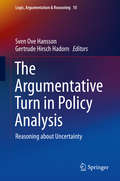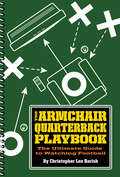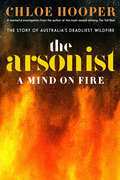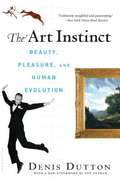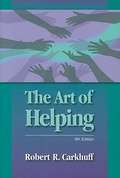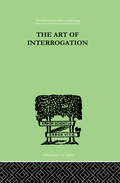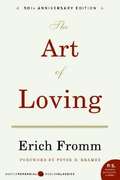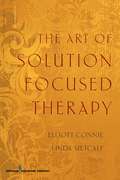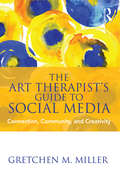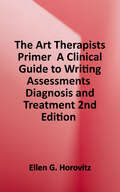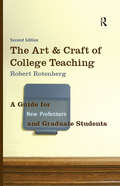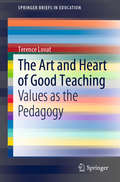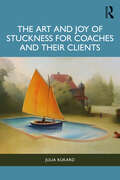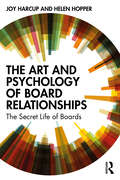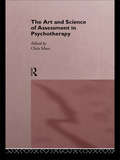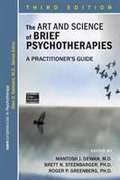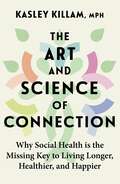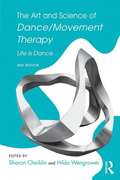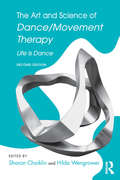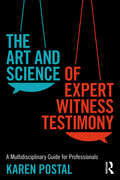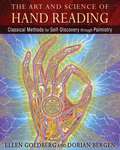- Table View
- List View
The Architecture of the Roman Triumph
by Maggie L. PopkinThis book offers the first critical study of the architecture of the Roman triumph, ancient Rome's most important victory ritual. Through case studies ranging from the republican to imperial periods, it demonstrates how powerfully monuments shaped how Romans performed, experienced, and remembered triumphs and, consequently, how Romans conceived of an urban identity for their city. Monuments highlighted Roman conquests of foreign peoples, enabled Romans to envision future triumphs, made triumphs more memorable through emotional arousal of spectators, and even generated distorted memories of triumphs that might never have occurred. This book illustrates the far-reaching impact of the architecture of the triumph on how Romans thought about this ritual and, ultimately, their own place within the Mediterranean world. In doing so, it offers a new model for historicizing the interrelations between monuments, individual and shared memory, and collective identities.
The Archive and the Repertoire: Performing Cultural Memory in the Americas
by Diana TaylorIn The Archive and the Repertoire preeminent performance studies scholar Diana Taylor provides a new understanding of the vital role of performance in the Americas. From plays to official events to grassroots protests, performance, she argues, must be taken seriously as a means of storing and transmitting knowledge. Taylor reveals how the repertoire of embodied memory--conveyed in gestures, the spoken word, movement, dance, song, and other performances--offers alternative perspectives to those derived from the written archive and is particularly useful to a reconsideration of historical processes of transnational contact. The Archive and the Repertoire invites a remapping of the Americas based on traditions of embodied practice. Examining various genres of performance including demonstrations by the children of the disappeared in Argentina, the Peruvian theatre group Yuyachkani, and televised astrological readings by Univision personality Walter Mercado, Taylor explores how the archive and the repertoire work together to make political claims, transmit traumatic memory, and forge a new sense of cultural identity. Through her consideration of performances such as Coco Fusco and Guillermo Gmez-Pea's show Two Undiscovered Amerindians Visit . . . , Taylor illuminates how scenarios of discovery and conquest haunt the Americas, trapping even those who attempt to dismantle them. Meditating on events like those of September 11, 2001 and media representations of them, she examines both the crucial role of performance in contemporary culture and her own role as witness to and participant in hemispheric dramas. The Archive and the Repertoire is a compelling demonstration of the many ways that the study of performance enables a deeper understanding of the past and present, of ourselves and others.
The Argumentative Turn in Policy Analysis
by Sven Ove Hansson Gertrude Hirsch HadornThisbook describes argumentative tools and strategies that can be used to guidepolicy decisions under conditions of great uncertainty. Contributing authorsexplore methods from philosophical analysis and in particular argumentationanalysis, showing how it can be used to systematize discussions about policyissues involving great uncertainty. The first part of the work exploreshow to deal in a systematic way with decision-making when there may be pluralperspectives on the decision problem, along with unknown consequences of whatwe do. Readers will see how argumentation tools can be used for prioritizingamong uncertain dangers, for determining how decisions should be framed, forchoosing a suitable time frame for a decision, and for systematically choosingamong different decision options. Case studies are presented in thesecond part of the book, showing argumentation in practice in the areas ofclimate geoengineering, water governance, synthetic biology, nuclear waste, andfinancial markets. In one example, argumentation analysis is applied toproposals to solve the climate problem with various technological manipulationsof the natural climate system, such as massive dispersion of reflectiveaerosols into the stratosphere. Even after a thorough investigation of such aproposal, doubt remains as to whether all the potential risks have beenidentified. In such discussions, conventional risk analysis does not have muchto contribute since it presupposes that the risks have been identified, whereasthe argumentative approach to uncertainty management can be used to systematizediscussions.
The Armchair Quarterback Playbook: The Ultimate Guide to Watching Football
by Christopher Lee BarishEvery weekend from August through January, 25 million Americans plop into their Lay-Z-Boys, crack open a beer, and watch football on television. At last, here is an illustrated book that celebrates their pastime and codifies their culture of extreme devotion like no other. The Armchair Quarterback Playbook is both hilarious and authentic, and is designed like a real football playbookcomplete with modified X and O diagrams. Everything a stay-at-home fan needs to know is here: how to redirect an interfering spouse ("The Listen and Respond Fake"), methods for keeping children at bay ("Intentional Grounding), equipment and etiquette tips, game food recipes, armchair quarterback vernacular, and more. Written by a certified "AQ," this is the perfect book for the football fanatic.
The Arsonist: A Mind on Fire
by Chloe HooperThe true story of the most devastating wildfire in Australian history and the search for the man who started it.What kind of person would deliberately start a firestorm? What kind of mind? On the scorching February day in 2009 that became known as Black Saturday, a man lit two fires in Victoria's Latrobe Valley, then sat on the roof of his house to watch the inferno. In the Valley, where the rates of crime were the highest in the state, more than thirty people were known to the police as firebugs. But the detectives soon found themselves on the trail of a man they didn't know. The Arsonist takes readers on the hunt for this man, and inside the strange puzzle of his mind. This book is also the story of fire in Australia, and of a community that owed its existence to that very element. The command of fire has defined and sustained us as a species--understanding its abuse will shape our future. A powerful true-crime thriller written with Hooper's trademark lyric detail and nuance, The Arsonist is a reminder that in an age of fire, all of us are gatekeepers.
The Art Instinct: Beauty, Pleasure, & Human Evolution
by Denis DuttonThe Art Instinct combines two of the most fascinating and contentious disciplines, art and evolutionary science, in a provocative new work that will revolutionize the way art itself is perceived. Aesthetic taste, argues Denis Dutton, is an evolutionary trait, and is shaped by natural selection. It's not, as almost all contemporary art criticism and academic theory would have it, "socially constructed.
The Art Of Helping
by Robert CarkhuffThis is the ninth edition of The Art of Helping. More than 500,000 copies have been sold over three decades. Literally, millions of people have been trained in helping skills. Many more have been recipients of these skills. The effects upon hundreds of thousand of these recipients have been researched. The results are in: skills acquisition and use are spectacularly powerful. This book explains the essential interpersonal skills needed by professional and lay counselors, teachers, business managers, parents, everyone. All in an easy to understand manner.
The Art Of Interrogation: Studies in the Principles of Mental Tests and Examinations (International Library Of Psychology Ser.)
by Hamilton, E RFirst published in 1999. Routledge is an imprint of Taylor & Francis, an informa company.
The Art Of Loving
by Peter D. Kramer Erich Fromm Rainer Funk Marion PauckThe fiftieth Anniversary Edition of the groundbreaking international bestseller that has shown millions of readers how to achieve rich, productive lives by developing their hidden capacities for love Most people are unable to love on the only level that truly matters: love that is compounded of maturity, self-knowledge, and courage. As with every art, love demands practice and concentration, as well as genuine insight and understanding. In his classic work, The Art of Loving, renowned psychoanalyst and social philosopher Erich Fromm explores love in all its aspects--not only romantic love, steeped in false conceptions and lofty expectations, but also brotherly love, erotic love, self-love, the love of God, and the love of parents for their children.
The Art Of Solution Focused Therapy
by Linda Metcalf Elliott ConnieWhat is Solution-Focused Therapy? Solution Focused Therapy (SFT) is a unique, goal-directed therapy aimed at helping clients regain autonomy by determining and achieving their own goals. Solution focused therapists encourage clients to focus on solutions, not problems, and help clients effectively plan how to reach their goals. Unlike other therapies, SFT holds an abiding belief in clients' abilities to know what is best for them, rather than have a therapist tell them. Why this book? This book not only provides an overview of the Solution Focused therapy model, its basic tenets, and theories; it also presents intimate interviews with expert practitioners-all of whom use SFT in their own practice. To this end, the book offers a wealth of insight into the theory and practice of SFT, to help practitioners decide whether SFT is right for them and their clients. These experts offer details of their apprehensions, goals, breakthroughs, and overall experiences with the therapy. The team of expert contributors includes Eve Lipchik, Yvonne Dolan, Alasdair Macdonald, Thorana Nelson, and many more. Questions the experts address include: How did you discover that SFT was the model that fit your clients' needs? What characteristics of this model drew you towards it? How has SFT impacted your personal life? What is it about SFT that makes it so effective? What are your favorite cases and how did they affect your work as a therapist?
The Art Therapist's Guide to Social Media: Connection, Community, and Creativity
by Gretchen M. MillerThe Art Therapist’s Guide to Social Media offers the art therapy community a guide that addresses content related to social media use, its growing influence, and the impact social networking has on the profession and work of art therapists. This book presents a framework of relevant theories, best practices, and examples to explore existing and emerging areas of social networking's power for art therapists as practitioners and artists. Divided into three sections that highlight the themes of connection, community, and creativity, chapters explore timely topics such as the professional use of social media, ethical considerations, potential benefits and challenges, and strategies to embrace the possibilities that social media can create for the field worldwide. Art therapists in training, art therapy educators and supervisors, and practicing art therapists will find content in this text helpful for their learning and professional practice.
The Art Therapists' Primer: A Clinical Guide to Writing Assessments, Diagnosis, and Treatment
by Ellen G. HorovitzThis landmark publication has been thoroughly revised and brought up to date in the Second Edition. Doctor Ellen G. Horovitz shares over thirty-five years of experience as she transliterates evidence-based art therapy into medical terminology. <p><p>This treatise spells out the how-to's behind producing art therapy assessments, process notes, significant sessions, objectives and modalities, termination summaries and internet-based assessments into translatable documentation, designed to dovetail within an interdisciplinary medical model. This step-by-step methodology fashions these reports, places art therapy on equal footing with all mental health workers and generates records, which serves as points of departure for future practitioners. <p><p>The experienced clinician will gather pertinent skills to enhance his or her practice. The student or seasoned graduate will harness the necessary armament to write clinically-based reports that serve as a model for the field, and educators can use this manual as a teaching tool. The Appendices (A-L) provide a wealth of information and forms to use in a clinically-based art therapy practice. Recording and communicating clinical findings in a cogent manner to a clinical medical and/or educational team is the trademark of this opus. In addition, there is a DVD located in the back of this book where the reader will find all the Appendix Forms, all images in color (by chapter) and three movies on conducting the CATA, ATDA and BATA. <p><p>This must-have reference manual amasses information that will serve as a companion guide for every art therapist (neophyte or seasoned) to formulate clinical reports, and it will aid clients towards a trajectory of wellness, recovery and, above all, health. Through the guidance of Horovitz's milestone text, art therapists will not only walk the walk, but more significantly, learn how to talk the talk.
The Art and Art Therapy of Papermaking: Material, Methods, and Applications
by Gretchen M. Miller Drew Luan MatottThe Art and Art Therapy of Papermaking: Material, Methods, and Applications provides a comprehensive collection about the contemporary practices, media, and value of hand papermaking as social engagement, art therapy, and personal voice. Divided into three parts that highlight each of these areas, contributors explore topics such as advocacy, work with survivors, community outreach, medical challenges, and how papermaking can empower creative expression, stories of change, recovery, and reclamation to address trauma, grief and loss, social action, and life experiences. Previous books have covered hand papermaking or art therapy media as stand-alone subjects; this text is the first of its kind that unites and describes the convergence of papermaking in all these forms. Art therapists, art educators, and artists will find this book essential to their education about how papermaking can be a powerful process to make meaning for the self, groups, and community.
The Art and Craft of College Teaching: A Guide for New Professors and Graduate Students
by Robert RotenbergThe second edition of Rotenberg’s popular guide to college teaching includes additional material on teaching in a digital environment, universal design, and teaching diverse students. As in the first edition, the book provides a hands-on, quick-start guide to the complexities of the college classroom for instructors in their first five years of teaching independently. The chapters survey the existing literature on how to effectively teach young adults, offering specific solutions to the most commonly faced classroom dilemmas. The author, a former department chair and award-winning instructor, encourages the new teacher to support their students as individual learners who are engaged in a program of study beyond their individual class. A focus on the choices made during the design of the course helps the instructor coordinate their class with a department or college curriculum. An extensive discussion of the relationship between classroom design and class size, as well as tips of assessment and grading, enable the new instructor to better handle the challenges of contemporary college classrooms.
The Art and Heart of Good Teaching: Values as the Pedagogy (SpringerBriefs in Education)
by Terence LovatThis book summarizes and updates findings from the Australian Values Education Program with a focus on the latest international research in the field, both theoretical and practice-based. Further, it provides a theoretical and practical basis for understanding the disenchantment with low-level accountability approaches to learning (e.g. NAPLAN in Australia). In turn, the book demonstrates the effectiveness of Values Education as a holistic pedagogy with the potential to enhance students’ learning effects in terms of their personal, social, emotional and academic development. It offers well-tested alternative pedagogical approaches, based on research insights largely originating from actual classroom-based practice.
The Art and Joy of Stuckness for Coaches and their Clients
by Julia KukardThis book offers an existential understanding of the process of stuckness, exploring how we can soften stuckness and become more fluid in our work and world.We can’t avoid getting stuck, it’s a vital part of learning and healing, but we can develop the skills to get stuck less painfully and recover quicker. When we do this, stuckness can enable us to process our pasts and incubate our futures. Illustrated by relatable, global case studies, this book will help readers and coaches understand and work with stuckness in their own and their clients’ lives.Based on the author's doctoral research and extensive experience as a coach and coach trainer globally, this book is valuable to coaches, therapists, and human development practitioners.
The Art and Psychology of Board Relationships: The Secret Life of Boards
by Joy Harcup Helen HopperThe relationships within boards can make or break an organisation, but well-functioning relationships take skill and effort to maintain. This book looks at the psychology behind individual and group behaviour and offers tactics and power tools to help make a success of your board career. The book shares advice and practical tips from 40 experienced board members from the worlds of corporates, the public sector and charities on how to spot and manage complex dynamics. And each chapter ends with techniques for unlocking tricky board relationships that you can put into practice immediately. The authors examine case studies and explore topics such as psychodynamics, cognitive behavioural psychology and neuroscience for insights into how boards react under pressure. They then demonstrate how to practise the ART of managing board relationships by increasing Awareness, Relating constructively to others, and choosing Tactics to ease tensions and foster collaboration. The Art and Psychology of Board Relationships: The Secret Life of Boards reveals why board relationships lie at the heart of organisational success – and how you can use them to gain competitive edge. It is essential reading for current and aspiring board members, coaches, facilitators and anyone with an interest in boardroom dynamics.
The Art and Science of Assessment in Psychotherapy
by Chris MaceWhile professional trainings in psychotherapy and counselling vary considerably in the attention they pay to assessment, courses, conferences and workshops devoted to the subject are attracting an audience eager for more demonstration and discussion. In response, The Art and Science of Assessment in Psychotherapy offers an extended symposium on principles and practice. Guided by a belief that comparative study will spur critical reflection and innovation, its presentations encompass a wide range of therapeutic orientations, settings and interests. In the book twelve distinguished practitioners of widely used approaches within psychotherapy describe the methods they use in their assessments and how these have developed. They also discuss the uses and limitations of the therapies they offer. The approaches covered include psychoanalytic psychotherapy, in-patient psychotherapy, family therapy, group psychotherapy, psychodrama, cognitive-behaviour therapy, couple therapy and focal therapy. Additional chapters look at assessment in the light of psychotherapy research, question how far assessment can be separated from treatment, and ask whether the use of questionnaires and special tests aids or detracts from interviewing as a method of assessment. As psychotherapy matures as a profession, both chronologically and in response to public demand, interest in assessment methods is growing, yet to date the published material has been limited and dispersed amongst specialist books and journals. The Art and Science of Assessment in Psychotherapy offer the first comprehensive, practical review of a key professional issue which will be of interest to all practising psychotherapists and counsellors.
The Art and Science of Brief Psychotherapies: A Practitioner's Guide
by Brett N. Steenbarger Mantosh J. Dewan Roger P. GreenbergWith all of the expert-authored content that made previous editions indispensable references for students and practitioners alike, this third edition of The Art and Science of Brief Psychotherapies: A Practitioner's Guide has been updated to reflect this rapidly changing field. Most chapters include new material that documents recent developments within existing models, and new chapters tackle topics that include the following: * Multicultural practice* Mentalizing* Motivational interviewing* Dialectical behavior therapy* Telepsychiatry* Internet-based interventions All chapters summarize the ideas underlying each modality, the evidence for effectiveness, and the techniques and interventions central to each. In a national and global environment of limited economic resources and multiple demands on patients' time, short-term treatment modalities are increasingly important. Integrating theory, research, and step-by-step procedures, The Art and Science of Brief Psychotherapies is an ideal introduction to the range of short-term therapies for psychiatry residents, psychology interns, social work students, and experienced practitioners looking to broaden their practice.
The Art and Science of Connection: Why Social Health Is the Missing Key to Living Longer, Healthier, and Happier
by Kasley KillamA groundbreaking redefinition of what it means to be healthy that introduces the need for social health—the part of wellbeing that comes from feeling connected—to truly flourish.Exercise. Eat a balanced diet. Go to therapy. Most wellness advice is focused on achieving and maintaining good physical and mental health. But Harvard-trained social scientist and pioneering social health expert Kasley Killam reveals that this approach is missing a vital component: human connection. Relationships not only make us happier, but also are critical to our overall health and longevity. Research shows that people with a strong sense of belonging are 2.6 times more likely to report good or excellent health. Perhaps even more astonishingly, people who lack social support are up to 53% more likely to die from any cause. Yet social health has been overlooked and underappreciated—until now.Just as we exercise our physical muscles, we can strengthen our social muscles. Weaving together cutting-edge science, mindset shifts, and practical wisdom, Killam offers the first methodology for how to be socially healthy. An antidote to the loneliness epidemic and an inspiring manifesto for seeing wellbeing as not only physical and mental, but also social, The Art and Science of Connection is a handbook for thriving. In this essential book, you will:Learn a simple yet powerful framework to understand, evaluate, and bolster your social health.Discover the exact strategy or habit you need, as well as research-backed tips, to cultivate and sustain meaningful connection now and throughout your life.Glean actionable insights to develop a sense of community in your neighborhood, at work, and online from a spirited group of neighbors in Paris, the CEO of a major healthcare company, and an artificially intelligent chatbot.Get an insider look at the innovative ways that doctors, teachers, entrepreneurs, architects, government leaders, and everyday people are catalyzing a movement toward a more socially healthy society.The Art and Science of Connection will transform the way you think about each interaction with a friend, family member, coworker, or neighbor, and give you the tools you need to live a more connected and healthy life—whether you are an introvert or extrovert, if you feel stretched thin, and no matter your age or background. Along the way, Killam will reveal how a university student, a newlywed, a working professional, and a retired widow overcame challenges to thrive through connection—and how you can, too.
The Art and Science of Connection: Why Social Health is the Missing Key to Living Longer, Healthier, and Happier
by Kasley KillamA groundbreaking redefinition of what it means to be healthy that introduces the need for social health - the part of wellbeing that comes from feeling connected - to truly flourish.Exercise. Eat a balanced diet. Go to therapy. Most wellness advice is focused on achieving and maintaining good physical and mental health. But Harvard-trained social scientist and pioneering social health expert Kasley Killam reveals that this approach is missing a vital component: human connection.Relationships not only make us happier, but also are critical to our overall health and longevity. Research shows that people with a strong sense of belonging are 2.6 times more likely to report good or excellent health. Perhaps even more astonishingly, people who lack social support are up to 53% more likely to die from any cause. Yet social health has been overlooked and underappreciated - until now.Just as we exercise our physical muscles, we can strengthen our social muscles. Weaving together cutting-edge science, mindset shifts, and practical wisdom, Killam offers the first methodology for how to be socially healthy. An antidote to the loneliness epidemic and an inspiring manifesto for seeing wellbeing as not only physical and mental, but also social, The Art and Science of Connection is a handbook for thriving.In this essential book, you will:- Learn a simple yet powerful framework to understand, evaluate, and bolster your social health.- Discover the exact strategy or habit you need, as well as research-backed tips, to cultivate and sustain meaningful connection now and throughout your life.- Glean actionable insights to develop a sense of community in your neighbourhood, at work, and online from a spirited group of neighbours in Paris, the CEO of a major healthcare company, and an artificially intelligent chatbot.- Get an insider look at the innovative ways that doctors, teachers, entrepreneurs, architects, government leaders, and everyday people are catalysing a movement toward a more socially healthy society.The Art and Science of Connection will transform the way you think about each interaction with a friend, family member, coworker, or neighbour, and give you the tools you need to live a more connected and healthy life - whether you are an introvert or extrovert, if you feel stretched thin, and no matter your age or background. Along the way, Killam will reveal how a university student, a newlywed, a working professional, and a retired widow overcame challenges to thrive through connection-and how you can, too.
The Art and Science of Dance/Movement Therapy Life is Dance: Life is Dance (2nd Edition)
by Hilda Wengrower Sharon ChaiklinThis second edition of The Art and Science of Dance/Movement Therapy offers a broad understanding of dance/movement therapy as well as an in-depth exploration of how and where it can be used to produce change. The chapters that make up this innovative volume go beyond the basics to offer a unique collection of theoretical perspectives paired with case studies designed to emphasize techniques that can be applied in a variety of settings. In addition to boasting thoroughly expanded versions of all previously published content, this timely reference includes an all new chapter on DMT interventions in palliative care and added references throughout to reflect to the most current knowledge.
The Art and Science of Dance/Movement Therapy: Life Is Dance
by Hilda Wengrower Sharon ChaiklinThe Art and Science of Dance/Movement Therapy offers both a broad understanding and an in-depth view of how and where dance therapy can be used to produce change. The chapters go beyond the basics that characterize much of the literature on dance/movement therapy, and each of the topics covered offers a theoretical perspective followed by case studies that emphasize the techniques used in the varied settings. Several different theoretical points of view are presented in the chapters, illuminating the different paths through which dance can be approached in therapy.
The Art and Science of Expert Witness Testimony: A Multidisciplinary Guide for Professionals
by Karen PostalFeaturing in-depth interviews of attorneys, judges, and seasoned forensic experts from multiple disciplines including psychology, medicine, economics, history, and neuropsychology, The Art and Science of Expert Witness Testimony highlights and offers bridges for the areas where the needs and expectations of the courtroom collide with experts’ communication habits developed over years of academic and professional training. Rather than seeing testimony as a one-way download from expert to jurors, The Art and Science of Expert Witness Testimony focuses on the direct, dynamic, unique communication relationship that develops as each juror’s lived experience interacts with the words of experts on the stand. This book expands the academic tradition of "methods-centered credibility" to also include "person-centered credibility," where warmth, confidence, and relentless attention to detail build trust with jurors. Seasoned forensic experts share what they actually say on the stand: their best strategies and techniques for disrupting traditional academic communication and creating access to science and professional opinions with vivid, clear language and strong visuals. The difficult but necessary emotional work of the courtroom is addressed with specific techniques to regulate emotions in order to maintain person-centered credibility and keep the needs of jurors front and center through cross-examination. This innovative compilation of research is essential reading for professionals and practitioners, such as physicians, engineers, accountants, and scientists, that may find themselves experts in a courtroom. The Art and Science of Expert Witness Testimony provides a unique experience for readers, akin to being personally mentored by over eighty-five attorneys, judges, and seasoned experts as they share their observations, insights, and strategies—not to "win" as a defense, prosecution, or plaintiff expert, but to be productive in helping jurors and other triers of fact do their difficult intellectual job in deciding a case.
The Art and Science of Hand Reading: Classical Methods for Self-Discovery through Palmistry
by Ellen Goldberg Dorian BergenA comprehensive guide to the inner psychology revealed by the hand • Details how to interpret the entire hand--the shape of the palm and fingers, mounts, lines, fingerprints, flexibility, nails, and skin texture • Reveals the personality archetypes, strengths, and weaknesses connected with each of the seven mounts and how the rest of the hand modifies these traits • Explains how lines change and the decisive influence of the person’s own mind in healing defects found on the lines Palmistry is a science and a universal language. The hand tells a story about your talents, relationships, health, and how you feel about yourself. It reveals periods of ease or challenge in your life, and it speaks about your weaknesses and the traits you need to develop. As you change, so do your hands, reflecting the progress you have made. In this comprehensive guide to hand reading, based on Ellen Goldberg’s 40 years of teaching palmistry and the Western Mystery tradition, the authors make the powerful insights of the hand accessible in an inviting and user-friendly manner. The book presents the character traits and personality archetypes associated with each of the seven mounts of the palm and shows how to determine which are most influential in the nature of the individual. The mount archetypes reveal the lifestyle, love,sex, and marriage preferences; the best career choices; and the unique strengths and weaknesses for each person. The book also examines other factors that enhance the qualities revealed by the mount types, including the flexibility of the hand, texture of the skin, and the shapes of the fingers, fingertips, and nails. The meaning of each major and minor line is described in detail as well as the influence the person’s own mind has in healing defects and obstacles found on their lines. The authors also provide accurate timing guides for each line, making it possible to locate specific events and to see how your lines change over time. Presenting the hand as a guide to self-fulfillment, The Art and Science of Hand Reading incorporates correspondences to other mystical sciences such as astrology, Kabbalah, the Hermetic teachings, and archetypal psychology. It also includes practical examples and more than 600 illustrations to show how to integrate the meanings of each part of the hand to form a complete picture of your inner psychology and your ever-changing destiny.


